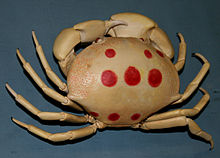†ArabicarcinidaeSchweitzer & Feldmann, 2017
CarpiliidaeOrtmann, 1893
- † Braggicarpilius Beschin, Busulini & Tessier, 2015
- † Bryocarpilius Feldmann, Schweitzer, Bennett, Franţescu, Resar & Trudeau, 2011
- Carpilius A. G. Desmarest, 1823
- † Corallicarpilius De Angeli & Ceccon, 2015
- † Eocarpilius Blow & Manning, 1996
- † Holcocarcinus Withers, 1924
- † Laticarpilius Feldmann, Schweitzer, Bennett, Franţescu, Resar & Trudeau, 2011
- † Liopsalis von Meyer, 1862
- † Lovaracarpilius Beschin, De Angeli, Checchi & Zarantonello, 2016
- † Maurocarpilius Ossó, Gagnaison & Bailleul, 2020
- † Montemagralia De Angeli & Ceccon, 2016
- † Ocalina Rathbun, 1929
- † Oscacarpilius Artal & Van Bakel, 2018
- † Palaeocarpilius A. Milne-Edwards, 1862
- † Paraocalina Beschin, Busulini, De Angeli & Tessier, 2007
- † Proxicarpilius Collins & Morris, 1978
- † Tethyscarpilius De Angeli & Alberti, 2016
†PaleoxanthopsidaeSchweitzer, 2003
- † Jakobsenius Schweitzer, 2005
- † Lobulata Schweitzer, Feldmann & Gingerich, 2004
- † Palaeoxantho Bishop, 1986
- † Palaeoxanthopsis Beurlen, 1958
- † Paraverrucoides Schweitzer, 2003
- † Remia Schweitzer, 2003
- † Rocacarcinus Schweitzer, 2005
- † Verrucoides Vega, Cosma, Coutiño, Feldmann, Nyborg, Schweitzer & Waugh, 2001
†TumidocarcinidaeSchweitzer, 2005
- † Agostella Ossó-Morales, 2011
- † Baricarcinus Casadío, De Angeli, Feldmann, Garassino, Hetler, Parras & Schweitzer, 2004
- † Cyclocorystes Bell, 1858
- † Dynomenopsis Secrétan, 1972
- † Lobonotus A. Milne-Edwards, 1863
- † Nitotacarcinus Schweitzer, Artal, Van Bakel, Jagt & Karasawa, 2007
- † Paratumidocarcinus Martins-Neto, 2001
- † Paronacarcinus Beschin, Busulini & Tessier, 2009
- † Pulalius Schweitzer, Feldmann, Tucker & Berglund, 2000
- † Romualdocarcinus Prado & Luque in Prado, Luque, Barreto & Palmer, 2018
- † Styracocarcinus Schweitzer & Feldmann, 2012
- † Titanocarcinus A. Milne-Edwards, 1863
- † Tumidocarcinus Glaessner, 1960
- † Xanthilites Bell, 1858
†ZanthopsidaeVía Boada, 1959


